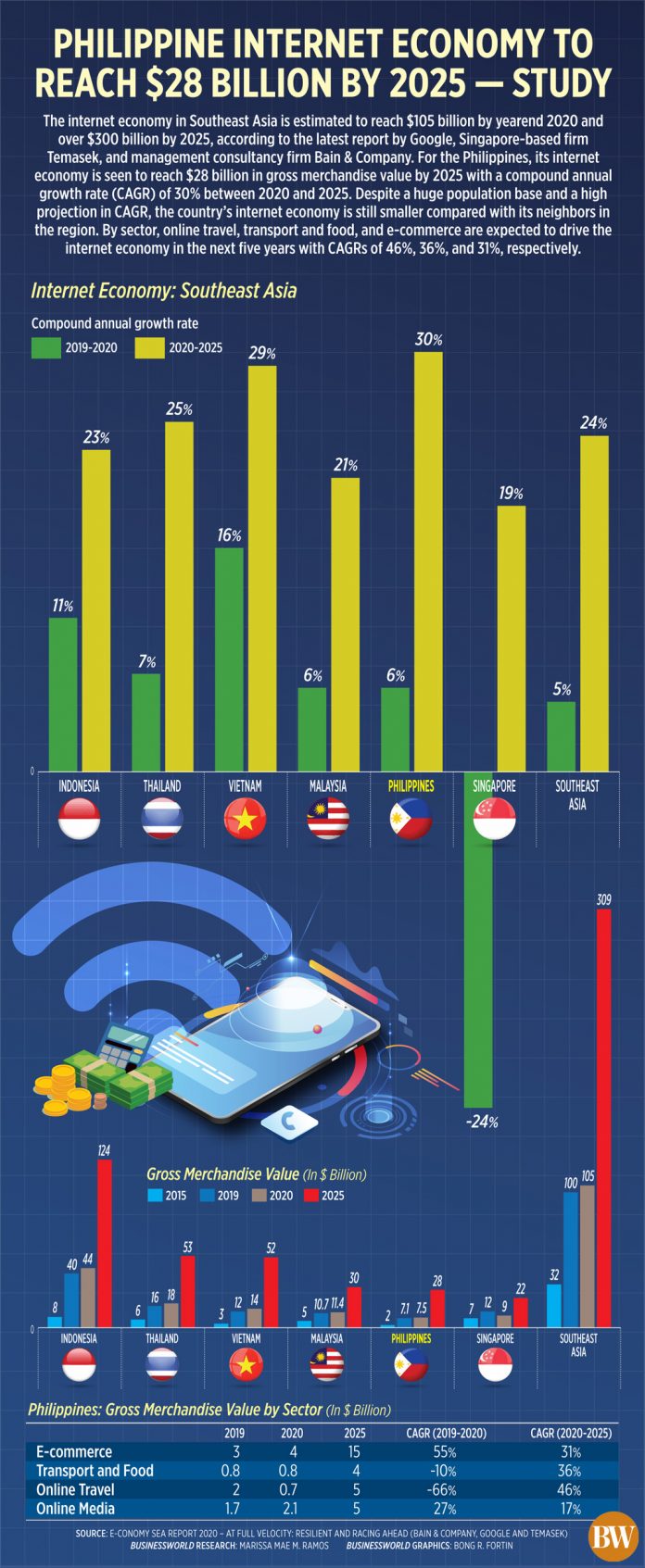THE Philippine digital economy’s gross merchandise value (GMV) is seen to hit $28 billion in 2025, accelerating to a 30% compound annual growth rate (CAGR), driven by the growth in new digital consumers, the latest e-Conomy Southeast Asia report by Bain & Company, Google, and Temasek said.
The digital economy’s GMV is expected to grow at a CAGR of 6% to $7.5 billion this year, which was described as “resilient.”
The e-Conomy Southeast Asia report made use of data from consumer and merchant surveys, corroborated with market participant interviews and databases. It focused on six markets, namely Indonesia, Malaysia, the Philippines, Singapore, Thailand and Vietnam.
As the pandemic helped drive Filipino consumers’ shift to digital services, the report showed 37% of new digital consumers plan to continue using internet economy services even after the pandemic. Among the new digital consumers, 95% said they will continue to use at least one digital service after the health crisis.
The study also found that the average hours spent by Filipinos online per day had increased to 5.2 hours during the strict lockdown, from four hours previously. This declined to 4.9 hours after the lockdown eased.
“In the Philippines, given the extensive COVID-19 (coronavirus disease 2019) lockdown periods, users went online searching for solutions to their sudden, new challenges,” the study noted.
Growth in e-commerce and online media offset the decline in transport, food, and travel sectors this year. The e-commerce sector’s value is projected to increase by a CAGR of 55% to $4 billion this year, and by 31% to $15 billion in 2025.
The online media sector’s value is seen to rise by a CAGR of 27% to $2.1 billion in 2020, and hitting $5 billion in 2025.
While travel and transport sectors grew by less than a percent this year, both are expected to bounce back by 2025.
On the other hand, the value of investments in the Philippines’ internet sector rose 34.13% to $169 million in the first half of 2020 with a total of 22 investment deals, as compared with the $126 million posted in the same period a year ago with 32 investment deals.
“Deal activity across the region continued to grow unabated in the first half 2020. Investors are remaining cautiously optimistic and are doing fewer deals at more attractive valuations, in hope for higher returns in the long run. Where the goal of years prior has been ‘blitzscaling,’ investors are now looking for sustainable, profitable growth,” the study said.
The study identified six major barriers to growth: internet access, funding, consumer trust, payments, logistics and talent. This year, significant progress has been seen, particularly in payments and consumer trust.
Alessandro Cannarsi, co-author of the report and Lead Partner in Private Equity for Bain & Company Southeast Asia, offered three ways for investors to be able to tap into the region’s “burgeoning digital economy.”
Investors can “recalibrate towards sustainable and profitable growth” by refocusing on companies that progress towards “profitable organic growth rather than metrics driven by subsidization,” he said.
Investors can also differentiate between essential versus non-essential tech. “Focus on startups that drive improvements in efficiency and access to essential goods and services,” Mr. Cannarsi said. — Arjay L. Balinbin


